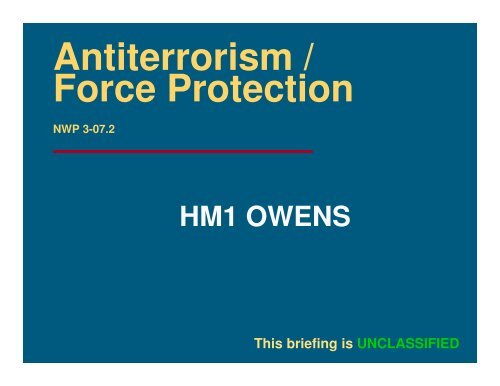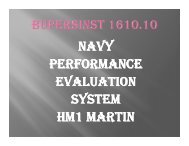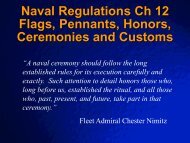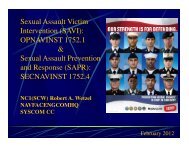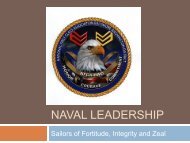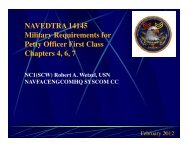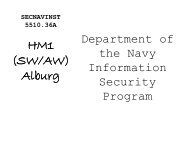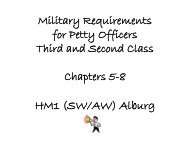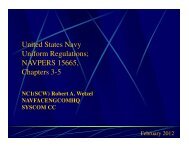Antiterrorism / Force Protection
Antiterrorism / Force Protection
Antiterrorism / Force Protection
- No tags were found...
You also want an ePaper? Increase the reach of your titles
YUMPU automatically turns print PDFs into web optimized ePapers that Google loves.
Overview of Training Definition of Terrorism <strong>Force</strong> <strong>Protection</strong> Defense Conditions Terrorism Threat Levels Phases of Terrorism Terrorists TacticsCT/CI Centers Navy AT/FP Program
Definition Department of Defense Definition of “Terrorism” Calculated use of violence or threat of violence to instillfear; intended to coerce or to intimidate governments orsocieties in the pursuit of goals that are generally political,religious, or ideological. Combating Terrorism involves actions including: <strong>Antiterrorism</strong>– defensive measures Counterterrorism– offensive measures
FORCE PROTECTION DEFINITION Security program designed to protect Servicemember, civilian employees, family members,facilities, and equipment, in all locations. The situation is accomplished through plannedand integrated application of combatingterrorism, physical security, operations security,personal protective service, and supported byintelligence, counterintelligence, and othersecurity programs.
Types of Monitoring Conditions/LevelsType ofCondition/LevelWhat is beingmeasure/determinedControllingAuthorityRange/ScaleFPCONIndicates level ofproactive measures tosafeguard commandsin a geographic areaLocal areaCommanderD,C,B,A,NormalTerrorismThreat LevelLevel of Terroristthreat within a givencountry theaterCINC/DIA forglobal threatHigh, Signicant,Moderate, LowDEFCONUS <strong>Force</strong>s AlertPostureNCA/JCS inconjunctionwith CINCs1,2,3,4,5
<strong>Force</strong> <strong>Protection</strong> Conditions (FPCON) FPCON ALPHA – when there is a general threat of possible terroristactivity against personnel and facilities and the nature and extent ofwhich are unpredictable FPCON BRAVO – when an increased and more predictable threat ofterrorist activity exists. This measure must be capable of beingmaintained for weeks without causing undue hardship, affectingoperational capability, and aggravating relations with localauthorities FPCON CHARLIE – when an incident occurs or intelligence isreceived indicating some form of terrorist action against personneland facilities is imminent FPCON DELTA – applies in the immediate area where a terroristattack has occurred or when intelligence has been received thatterrorist action against a specific location or person is likely.
Terrorist Threat LevelLowNo terrorist group is detected or the group activity is non-threateningModerateTerrorists are present but there are no indications of anti-US activitySignificantAnti-US terrorists are present and attack personnel as their preferredmethod of operation, or a group uses large casualty producing attacks asits preferred method but has limited operational activityHighAnti-US terrorists are operationally active and use large casualty producingattacks as their preferred method of operation
Defense Condition (DEFCON) DEFCON 5Normal peacetime situation exists DEFCON 4Tensions exist which require greater military vigilance DEFCON 3Tensions exist which may have serious and adverse effects on U.S.interests DEFCON 2Situations exist which are directly susceptible to foreign exploitation byhostile action or other situations exist which are susceptible to hostileexploitation, either which could seriously threaten US forces overseas, USallies, or areas vital to US national interests. DEFCON 1International relations have deteriorated to such a degree that measuresmust be taken to achieve maximum readiness. Significant strategic and/ortactical indications of hostilities exist against US forces overseas, US allies,or the US or its possessions. War is imminent.
TERRORISTIDEAOLOGYPoliticsNationalismReligionSpecial InterestGOALS Recognition Elimination ofWestern Influence Harassment,Weakening orembarrassment ofgovernments. Attainment of moneyor equipment Destruction offacilities anddisruption ofcommunications Satisfying vengeance
TERRORIST CHARACTERISTICS Urban-Based: An urban environment offersaccess to transportation, money-launderingmechanisms, communications systems andinternational contacts who can provide requiredtravel documentation. Highly mobile: Terrorists typically movefrequently among cities and countries, not onlyto facilitate the planning and execution ofoperations, but also in search of safe havensand like-minded support
TERRORIST CHARACTERISTICS Well-Trained: In order to instill individualmembers with a strong desire for success,including a willingness to die for the cause,terrorist groups train and rehearse extensively.Emphasis is on physical conditioning, effectiveuse of weapons and explosives, tactics andcombat techniques, clandestine operations,psychological warfare and survival skills. Covert: Although some groups have overtpolitical contingents, the operational cells ofmost terrorist groups can operate in covertpostures for extended periods.
Phases of Terrorism Terrorism six-step process Phase One - Target Options Phase Two - Selection Surveillance Phase Three - Target Selection Phase Four - Detailed Surveillance Phase Five - Training and Preparation Phase Six - The Attack
ATTACK PREPARATIONS Target Options: Choosing a target typically starts with aself-assessment of the terrorist group’s capabilities,which will, in large part, define the methods of attackavailable to the group. Selection Surveillance: Data gathered from watchingpotential targets will help the terrorist group refine thelist of choices. A potential target may be de-selectedbecause surveillance data proves the choice to be toodifficult to effectively attack. Target Selection: Once surveillance data results areassessed, terrorists are able to select their target or setof targets. The most likely targets are those that arevulnerable, undefended or with weak security.
ATTACK PREPARATIONS Detailed Surveillance: Terrorists often conductfurther long-term, detailed surveillance of thechosen potential target(s), seeking to detectroutines, procedures and site-specific securitymeasures. Training and preparation: Once the terrorists’plan of attack has been developed, the attackteam will be chosen and trained. Attack: Terrorists wait for the right set ofcircumstances to attack, which can take monthsor even years.
Terrorists Tactics Common Terrorists Tactics Assassination Arson Bombing Hostage Taking Kidnapping Hijacking or Skyjacking Seizure Raids or Attacks On Facilities Sabotage Weapons of Mass Destruction (WMD) Information Warfare (IW)
Tasking The Intelligence CommunityNational Intelligence CommunityDOD Intelligence CentersNavy Intelligence AssetsRegionalIntelligenceCentersPriority IntelligenceRequirements/Requests For InformationUnitIntelligence Products
National CT/CI Centers Director of Central Intelligence, Counterterrorism Center(CTC) Lead center in U.S. to fight against terrorism Interagency Intelligence Committee on Terrorism (IICT) Forum for coordination and cooperation on CT issues Bureau of Intelligence and Research (INR) Primarily serve U.S. diplomatic corps; ensure intelligenceactivities are consistent with U.S. foreign policy Federal Bureau of Investigation (FBI) Responsible for detecting and counteracting foreignintelligence activities that affects U.S. national security
DOD CT/CI Centers Defense Intelligence Agency (DIA) Office of Counterterrorism,Threat Warning Center (TWC) TWC is the coordinating office for DIA on terrorism
Command and Regional CT/CI Centers Joint <strong>Force</strong>s Intelligence Command (JFIC) – Located in Norfolk, VA Joint Analysis Center USEUCOM (JAC) – Located in Molesworth, UK Joint Intelligence Operations Center USCENTCOM (JIOCCENT) –Located in Tampa, Florida Joint Intelligence Operations Center USPACOM (JIOCPAC) –Located in Pearl Harbor, Hawaii
Service Sponsored CT/CI Centers Naval Criminal Investigation Service (NCIS) – has primaryinvestigative and counterintelligence jurisdiction for the Navy NCIS has an AT/FP program that collects and analyzesinformation about possible threats and advises commanders onhow to best defend against them Navy Antiterrorist Alert Center (ATAC) – is the centerpiece for of theNavy’s efforts to counter terrorist threats, located in WashingtonD.C. Army Counterintelligence Center (ACIC) – provides timely, accurate,and effective counterintelligence and terrorism analysis support tothe Army Air <strong>Force</strong> Office of Special Investigation (AFOSI) – counters thethreat to Air <strong>Force</strong> security posed by hostile intelligence servicesand terrorist groups
BLUE DARTThere is a need to inform threatened unitsin a timely mannerBLUE DART messaged are disseminatedwhen intelligence indicates that aspecific, imminent, and credibleterrorists threat exists−Require acknowledgment byimmediate message by all actionaddressees, acknowledged byimmediate precedence
Consequence Management Phase One – Impacts and Consequences: Potential impactsand consequences of an incident focusing on worst casescenarios for a particular facility or unit Example = Multi-level building with severe damage orcollapse, trapped personnel Phase two – Resources Required: Resources required torespond to consequence and impacts of Phase One; whererequirements exceed resources, mitigating actions are taken Example = Resources needed to rescue trapped personnelin collapsed building; using non-DOD assets Phase Three – Training and Exercise: Once a consequencemanagement plan has been developed, personnel must betrained and the plan must be practiced
Navy AT/FP Program The Navy AT/FP program: Purpose is to ensure Navy forces remain mission capableat all times Focuses on preventing terrorist attacks on Navy assetsand personnel through education and training Combating terrorism is the responsibility of everyindividual in the Navy
Questions?This briefed was prepared with information derived from:NWP 3-07.2


